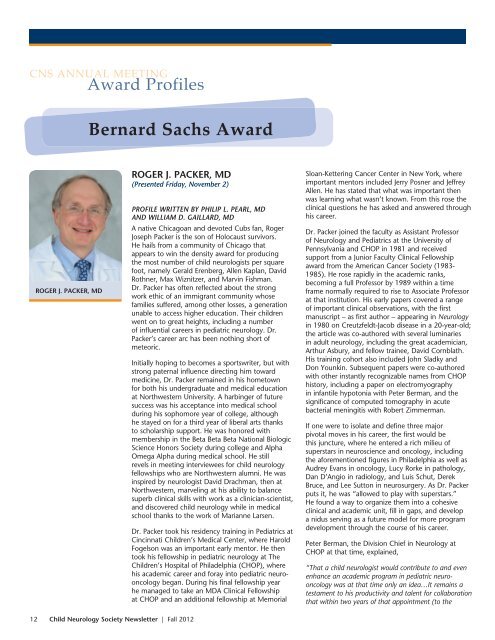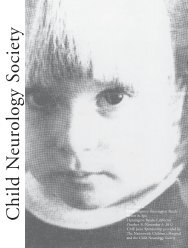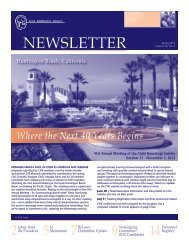to download the document - Child Neurology Society
to download the document - Child Neurology Society
to download the document - Child Neurology Society
Create successful ePaper yourself
Turn your PDF publications into a flip-book with our unique Google optimized e-Paper software.
Cns AnnUAl meetInG<br />
Award Profiles<br />
Bernard Sachs Award<br />
ROGER J. PACKER, MD<br />
ROGER J. PACKER, MD<br />
(Presented friday, November 2)<br />
Profile wriTTeN by PhiliP l. Pearl, MD<br />
aND williaM D. GaillarD, MD<br />
A native Chicagoan and devoted Cubs fan, Roger<br />
joseph Packer is <strong>the</strong> son of holocaust survivors.<br />
he hails from a community of Chicago that<br />
appears <strong>to</strong> win <strong>the</strong> density award for producing<br />
<strong>the</strong> most number of child neurologists per square<br />
foot, namely Gerald Erenberg, Allen Kaplan, David<br />
Rothner, Max Wiznitzer, and Marvin Fishman.<br />
Dr. Packer has often reflected about <strong>the</strong> strong<br />
work ethic of an immigrant community whose<br />
families suffered, among o<strong>the</strong>r losses, a generation<br />
unable <strong>to</strong> access higher education. Their children<br />
went on <strong>to</strong> great heights, including a number<br />
of influential careers in pediatric neurology. Dr.<br />
Packer’s career arc has been nothing short of<br />
meteoric.<br />
Initially hoping <strong>to</strong> becomes a sportswriter, but with<br />
strong paternal influence directing him <strong>to</strong>ward<br />
medicine, Dr. Packer remained in his home<strong>to</strong>wn<br />
for both his undergraduate and medical education<br />
at Northwestern University. A harbinger of future<br />
success was his acceptance in<strong>to</strong> medical school<br />
during his sophomore year of college, although<br />
he stayed on for a third year of liberal arts thanks<br />
<strong>to</strong> scholarship support. he was honored with<br />
membership in <strong>the</strong> Beta Beta Beta National Biologic<br />
Science honors <strong>Society</strong> during college and Alpha<br />
Omega Alpha during medical school. he still<br />
revels in meeting interviewees for child neurology<br />
fellowships who are Northwestern alumni. he was<br />
inspired by neurologist David Drachman, <strong>the</strong>n at<br />
Northwestern, marveling at his ability <strong>to</strong> balance<br />
superb clinical skills with work as a clinician-scientist,<br />
and discovered child neurology while in medical<br />
school thanks <strong>to</strong> <strong>the</strong> work of Marianne Larsen.<br />
Dr. Packer <strong>to</strong>ok his residency training in Pediatrics at<br />
Cincinnati <strong>Child</strong>ren’s Medical Center, where harold<br />
Fogelson was an important early men<strong>to</strong>r. he <strong>the</strong>n<br />
<strong>to</strong>ok his fellowship in pediatric neurology at The<br />
<strong>Child</strong>ren’s hospital of Philadelphia (ChOP), where<br />
his academic career and foray in<strong>to</strong> pediatric neurooncology<br />
began. During his final fellowship year<br />
he managed <strong>to</strong> take an MDA Clinical Fellowship<br />
at ChOP and an additional fellowship at Memorial<br />
Sloan-Kettering Cancer Center in New York, where<br />
important men<strong>to</strong>rs included jerry Posner and jeffrey<br />
Allen. he has stated that what was important <strong>the</strong>n<br />
was learning what wasn’t known. From this rose <strong>the</strong><br />
clinical questions he has asked and answered through<br />
his career.<br />
Dr. Packer joined <strong>the</strong> faculty as Assistant Professor<br />
of <strong>Neurology</strong> and Pediatrics at <strong>the</strong> University of<br />
Pennsylvania and ChOP in 1981 and received<br />
support from a junior Faculty Clinical Fellowship<br />
award from <strong>the</strong> American Cancer <strong>Society</strong> (1983-<br />
1985). he rose rapidly in <strong>the</strong> academic ranks,<br />
becoming a full Professor by 1989 within a time<br />
frame normally required <strong>to</strong> rise <strong>to</strong> Associate Professor<br />
at that institution. his early papers covered a range<br />
of important clinical observations, with <strong>the</strong> first<br />
manuscript – as first author – appearing in <strong>Neurology</strong><br />
in 1980 on Creutzfeldt-jacob disease in a 20-year-old;<br />
<strong>the</strong> article was co-authored with several luminaries<br />
in adult neurology, including <strong>the</strong> great academician,<br />
Arthur Asbury, and fellow trainee, David Cornblath.<br />
his training cohort also included john Sladky and<br />
Don Younkin. Subsequent papers were co-authored<br />
with o<strong>the</strong>r instantly recognizable names from ChOP<br />
his<strong>to</strong>ry, including a paper on electromyography<br />
in infantile hypo<strong>to</strong>nia with Peter Berman, and <strong>the</strong><br />
significance of computed <strong>to</strong>mography in acute<br />
bacterial meningitis with Robert Zimmerman.<br />
If one were <strong>to</strong> isolate and define three major<br />
pivotal moves in his career, <strong>the</strong> first would be<br />
this juncture, where he entered a rich milieu of<br />
superstars in neuroscience and oncology, including<br />
<strong>the</strong> aforementioned figures in Philadelphia as well as<br />
Audrey Evans in oncology, Lucy Rorke in pathology,<br />
Dan D’Angio in radiology, and Luis Schut, Derek<br />
Bruce, and Lee Sut<strong>to</strong>n in neurosurgery. As Dr. Packer<br />
puts it, he was “allowed <strong>to</strong> play with superstars.”<br />
he found a way <strong>to</strong> organize <strong>the</strong>m in<strong>to</strong> a cohesive<br />
clinical and academic unit, fill in gaps, and develop<br />
a nidus serving as a future model for more program<br />
development through <strong>the</strong> course of his career.<br />
Peter Berman, <strong>the</strong> Division Chief in <strong>Neurology</strong> at<br />
ChOP at that time, explained,<br />
“That a child neurologist would contribute <strong>to</strong> and even<br />
enhance an academic program in pediatric neurooncology<br />
was at that time only an idea…It remains a<br />
testament <strong>to</strong> his productivity and talent for collaboration<br />
that within two years of that appointment (<strong>to</strong> <strong>the</strong><br />
12 <strong>Child</strong> <strong>Neurology</strong> <strong>Society</strong> Newsletter | Fall 2012




